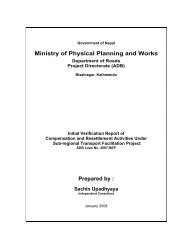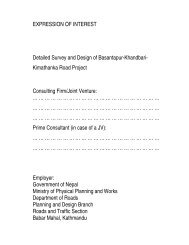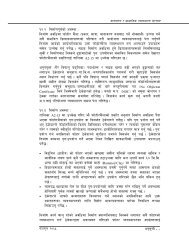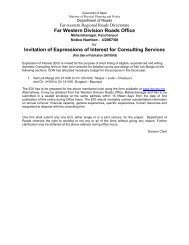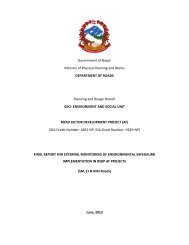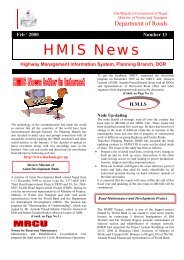Environmental & Social Management Framework - About ...
Environmental & Social Management Framework - About ...
Environmental & Social Management Framework - About ...
You also want an ePaper? Increase the reach of your titles
YUMPU automatically turns print PDFs into web optimized ePapers that Google loves.
<strong>Environmental</strong> and <strong>Social</strong> <strong>Management</strong> <strong>Framework</strong>• Institutions involved in project implementation (roles, strength andweakness) at different project stages, as well as supervision andmonitoring arrangements;• Maintenance approach (fund, institutional mechanism, human resources).(4) Identification and Analysis of Project AlternativesThis part of the EIA Report consists of a comprehensive discussion of pros andcons for alternative alignment of the proposed road (in map and description). Ithas to provide the explanation and argumentation for choice of options, takinginto account the respective environmental, socio-economic and costconsiderations. For each alternative, the potential impact on the environmentaland social setting needs to be discussed. Alternative assessment may include:Project Alternative• Alternative Route and Location• Alternative Design and Construction Methods• Alternative Resources (alternative construction materials)• Do nothing Alternative.(5) Identification and Analysis of Potential Direct and Indirect ImpactsFor the chosen project area all receptors of project-induced impacts need to bediscussed separately. This section of the report needs also the description anddefinition of the predicted zone of project influence. Typically, receptors includewater, air, soil, forest, fauna, flora, human beings, cultural assets, structures,buildings etc. The principal task of this section is to identify, predict andevaluate the intensity, extent and duration in which a project activity will have animpact on a receptor or multiple receptors, and multiple activities having impactson receptor, or how receptors(s) might have on project and its activities. Theresulting impacts (positive and negative) will be categorized, preferably in amatrix form (see below) as direct, indirect, combined/cumulative, synergistic,short termed, medium termed, long termed, reversible, irreversible, severe,moderate and insignificant (see Box 2.3).Box 2.3Types of Impacts Commonly Associated with Road Construction ProjectsDirect Impacts: Alteration of the existing environmental conditions as a directconsequence of project activity. These are site specific impacts such as if the roadpasses through forest and trees or vegetations are cleared as part of site clearance.Indirect or Induced Impacts: Such impacts occur when the effect of project activityon one component produces repercussions on other components. A direct impactmay also induce indirect or secondary impacts on environment. For examplelandslides that occur due to construction of road may lead to damage of cultivatedland and eventually loss of agricultural production.Cumulative Impacts: This is referred as the combination of impacts of two or moreprojects or combination of impacts of several activities of one project.Reversible Impacts: Impacts generated by particular action of project can beminimized through mitigation measures or by nature itself.Irreversible Impact: Impacts generated by project action that is unlikely (or costineffective)to be replaced by mitigation measures or by nature itself over the time.Beneficial Impacts: Road projects will generate various beneficial impacts onenvironment and society and will contribute to improve the quality of human life. ForChapter 2-14 April 2007



![j:6 ]zg cfof ]hgf](https://img.yumpu.com/51286794/1/190x245/j6-zg-cfof-hgf.jpg?quality=85)

![x'nfsL /fhdfu { cfof ]hgf](https://img.yumpu.com/50581959/1/190x245/xnfsl-fhdfu-cfof-hgf.jpg?quality=85)
